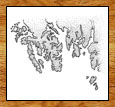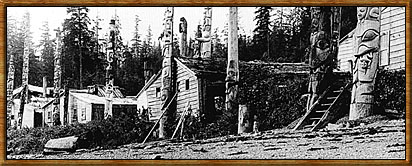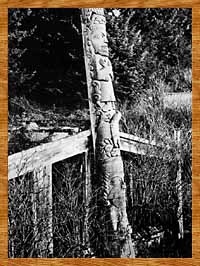 
|
Kasaan

Kasaan is originally a Tlingit word meaning Beautiful Town. The town chief, named Skowl, had a large house situated towards the north end of the settlement. When George T. Emmons first visited the village in 1885, he took a photo of old Chief Skowl's house after it had been freshly clad with milled siding. Chief Skowl also owned a second house in the village that had an unusual frontal pole.
Alfred P. Niblack witnessed the funeral ceremonies for old Chief Skowl, who died in the winter of 1882-83:
According to the custom of the region, his body was first displayed in state dressed in the ceremonial robes of a chief. Later it was enclosed in a casket and deposited, as shown, on a pile of boxes containing his clothing and ceremonial dance paraphernalia.

 |
This pole, in front of a second house in Kasaan belonging to Chief Skowl, depicts priests, an angel and Eagles. Rather than celebrating the arrival of the Russian Orthodox Church in Alaska, however, it ridicules the fact that young men from the villages wanted to train for the priesthood and abandon the old ways.
Photograph by A. Bergstresser, circa 1900.
CMC 71-4707 |

The dance house belonging to Chief Shakes was also an impressive building; it stood just behind his house, the last one at the north end of the second row. The frontal pole incorporates more non-Haida motifs and styles than any other piece; in fact, the only traditional element is the Eagle on top. Another Eagle with its head to one side is clearly an American eagle copied from a coin or a ship's figurehead. The figures on the pole include three Russians and one angel. The Russians are priests dressed in large flowing robes, hands crossed on their breasts -- or pointing to heaven, as in the figure at the top. The angel, whose face is surrounded on three sides by feather designs, is a particular delight. Other spaces, usually filled on traditional Haida poles by diminutive animal figures emerging from the orifices of larger figures, are decorated here with tendril and leaf patterns copied from the stylized ship carvings common at the time. This pole was transported to Ketchikan for restoration and was re-erected there.
Another leading chief of Kasaan was Soni-hat, whose name appears frequently in the Hudson's Bay Company journals for Fort Simpson for three decades beginning in the 1870s. He appears in a formal family portrait inside Whale House at Kasaan just before the turn of the century. In addition to the three generations of his relatives arranged around him, he displays all of his chiefly possessions: frontlets, a Chilkat blanket and leggings, a painted leather cape, two copper shields, a talking stick and piles of chests filled with other prerogatives of power. An exquisitely carved interior house post peeks out from behind this display of opulence.
Chief Soni-hat also owned a house in the second row at the south end of Kasaan, called Eagle House. Each of the interior house posts depicts a human figure with large bear's ears. The asymmetrical hand positions and the bear ears indicate a shaman figure, but it is not known why he chose a shaman motif for these posts. Soni-hat donated the carvings from this house as the first chief to answer a plea from Governor Brady of Alaska (1897-1906) for poles to be preserved in a park in Sitka.
The first Soni-hat pole has a large standing Bear, on top of which stood another Bear with its hands in an asymmetrical position grasping an otter by the tail (another reference to shamanic powers). Above that is a third standing Bear holding a small human figure (from the Bear Mother myth) and standing on two animal heads. Next is the Raven with a turned-down beak (from the Raven and the halibut fisherman myth), and above that is a Whale holding a human figure and a Frog, then a Bear holding its extended tongue. At the top are two watchmen looking in opposite directions.
A later but equally remarkable house at Kasaan was also named Eagle House. Its frontal pole stood for many years before the Heye Foundation Headquarters and Museum at 155th Street and Broadway in New York City, the only major outdoor Northwest Coast monument in that metropolis. This pole had a Raven sitting on top of four potlatch rings, emerging from the head of another Raven in reference to the myth of the halibut fisherman. The feathers of the Raven's wings hang below his arms. The figure below is from the Bear Mother story; the Bear is devouring the brother of the Bear Mother who tried to rescue her. Next is a Bear with frogs on its forehead and in its ears, holding a Raven. The bottom figure is a Beaver holding a smaller Beaver behind its tail.
The interior posts of this house were equally interesting. One pair portrayed the Raven with the moon in its beak. Inside the moon disk is the baby Raven, in reference to the story of how the Raven stole the sun, moon and stars while disguised as the infant of the Sky Chief's daughter. The other pair of posts depicted a large standing Bear Mother figure with a cub between her legs and a Frog emerging between her ears. From her lip hangs an engraved labret, and below her is the Raven with a broken beak (from the halibut fisherman myth).
Standing in front of Eagle House are two very old poles, carved in the 1850s by the noted Tlingit artist Kadjis-du-axtc, whose main work is found much further north around Sitka and Klinkwan (including the Whale House rear posts). A magnificent crest helmet depicting a Sculpin is on display in an old photo, taken in front of Eagle House by Charles F. Newcombe in 1902 just before it was collected by George T. Emmons for Lord Bossom. The helmet sits on a huge mask that is 1.2 m (4 feet) tall and that has mechanical shutters over its eyes. It is tempting to think that this large mask is the one described by Reverend Jonathan Green on his visit to Kasaan in 1829. At that time the mask was being used to cover a mortuary figure which held the remains of Chief Cunnyha, the same chief who had met Captain George Dixon in 1787 at Kiusta. He lived to a venerable age and died in Kasaan about 1820.
|